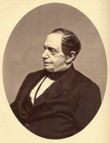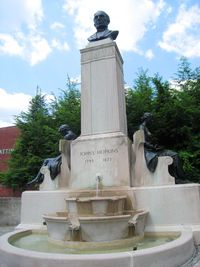| Johns Hopkins | |
|---|---|
 | |
| Born | May 19, 1795 Anne Arundel County, Maryland, U.S. |
| Died | December 24, 1873 (aged 78) Baltimore, MD, U.S. |
| Occupation | Entrepreneur, Investor, Philanthropist, Abolitionist |
| Religion | Society of Friends (Quakerism) |
Johns Hopkins (May 19, 1795 – December 24, 1873) was a wealthy entrepreneur, philanthropist, and abolitionist of 19th century Baltimore, now most noted for his philanthropic creation of the institutions that bear his name, namely the Johns Hopkins Hospital, and the Johns Hopkins University and its associated divisions, in particular the schools of nursing, medicine, and public health. A biography entitled Johns Hopkins: A Silhouette written by his cousin, Helen Hopkins Thom, was published in 1929 by the Johns Hopkins University Press.
Early Life
On May 19, 1795, Johns Hopkins was born on Whitehall, a 500-acre (two km²) tobacco plantation with approximately 500 slaves located in Anne Arundel County, Maryland. His first name, Johns (not John), was a family name. His great-grandmother, Margaret Johns, married Gerard Hopkins, and they named their son Johns Hopkins, a not-uncommon naming convention at the time; his name was then passed on to his grandson. His parents were Samuel Hopkins (1759-1814), of Anne Arundel County, and Hannah Janney (1774-1864), of Loudoun County, Virginia.
In 1807, the Hopkins family, who were members of the Society of Friends (Quakers), emancipated their slaves, which meant that the formal education of Johns, then 12, had to be interrupted in order to help out on the plantation. Moreover, his help was needed because he was the second oldest of eleven children and, as their local Friends society had decreed, the family freed only the able-bodied slaves, and had to provide for the less able-bodied slaves, who would remain at the plantation and provide labor as they were able. In 1812, at the age of 17, Hopkins left the plantation and went to Baltimore to work in the wholesale grocery business of his uncle, Gerard Hopkins. While living with his uncle's family, Johns and his cousin, Elizabeth, fell in love, but the taboo against the marriage of first cousins was especially strong among Quakers. Neither Johns nor Elizabeth ever married. Still, just as he would continue to provide for his extended family throughout his life and posthumously through his will, Hopkins bequeathed a home for Elizabeth, where she lived until her death in 1889.
Philanthropy
The Civil War had taken its toll on Baltimore, however, as did the yellow fever and cholera epidemics that repeatedly ravaged the nation's cities, killing 853 in Baltimore in the summer of 1832 alone. Hopkins was keenly aware of the city's need for medical facilities, particularly in light of the medical advances made during the war, and in 1870 he made a will setting aside seven million dollars - mostly in B&O stock - for the incorporation of a free hospital and affiliated medical and nurse's training colleges, as well as an orphanage for colored children and a university. Many board members were on both boards. The hospital and orphan asylum would each be overseen by the 12-member hospital board of trustees, and the university by the 12-member university board of trustees. Johns Hopkins' bequest was used to found posthumously the Johns Hopkins Colored Children Orphan Asylum first as he requested, in 1875; the Johns Hopkins University in 1876; the Johns Hopkins Press, the longest continuously operating academic press in America, in 1878; the Johns Hopkins Hospital and the Johns Hopkins School of Nursing in 1889; the Johns Hopkins University School of Medicine 1893; and the Johns Hopkins School of Hygiene and Public Health in 1916.
Johns Hopkins' views on his bequests, and on the duties and responsibilities of the two board of trustees, especially the hospital board of trustees led by his friend and fellow Quaker Francis King, were formally stated primarily in four documents, the incorporation papers filed in 1867, his instruction letter to the hospital trustees dated March 12 1873, his will, which was quoted from extensively in his Baltimore Sun obituary,[5] and in his will's two codicils, one dated 1870 and the other dated 1873.
In these documents, Hopkins also made provisions for scholarships to be provided for poor youths in the states where Johns Hopkins had made his wealth, as well as assistance to orphanages other than the one for African American children, to members of his family, to those he employed, black and white, his cousin Elizabeth, and, again, to other institutions for the care and education of youths regardless of color and the care of the elderly, and the ill, including the mentally ill, and convalescents.
John Rudolph Niernsee, one of most famous architects of the time, designed the orphan asylum and helped to design the Johns Hopkins Hospital. The original site for the Johns Hopkins University had been chosen personally by Hopkins. According to his will, it was to be located at his summer estate, Clifton. However, a decision was made not to found the university there. The property, now owned by the city of Baltimore, is the site of a golf course and a park named Clifton Park. While the Johns Hopkins Colored Children Orphan Asylum was founded by the hospital trustees, the other institutions that carry the name of "Johns Hopkins" were founded under the administration of the first president of the Johns Hopkins University and Johns Hopkins Hospital, Daniel Coit Gilman and his successors.
Colored Children Orphan Asylum
As per Johns Hopkins' instruction letter, the Johns Hopkins Colored Children Orphan Asylum (JHCCOA) was founded first, in 1875, a year before Gilman's inauguration, now the founding date of the university. The construction of the asylum, including its educational and living facilities, was praised by The Nation and the Baltimore American, the latter stating that the orphan asylum was a place where "nothing was wanting that could benefit science and humanity". As was done for other Johns Hopkins Institutions, it was planned after visits and correspondence with similar institutions in Europe and America.
The Johns Hopkins Orphan Asylum opened with 24 boys and girls. Under Gilman and his successors, this orphanage was later changed to serve as an orphanage and training school for black female orphans principally as domestic workers, and next as an "orthopedic convalescent" home and school for "colored crippled" children and orphans. The asylum was eventually closed in 1924 nearly fifty years after it opened, and was never reopened.
Hospital, University, Press, and Schools of Nursing and Medicine
As per Hopkins' March 1873 Instruction Letter, the School of Nursing was founded alongside the Hospital in 1889 by the hospital board of trustees in consultation with Florence Nightingale. Both the nursing school and the hospital were founded over a decade after the founding of the orphan asylum in 1875 and the university in 1876. Hopkins' instruction letter explicitly stated his vision for the hospital; first, to provide assistance to the poor of "all races", no matter the indigent patient's "age, sex or color"; second, that wealthier patients would pay for services and thereby subsidize the care provided to the indigent; third, that the hospital would be the administrative unit for the orphan asylum for African American children which was to receive $25,000 in annual support out of the hospital's half of the endowment; and fourth, that the hospital and orphan asylum should serve 400 patients and 400 children respectively, fifth, that the hospital should be part of the university, and, sixth, that religion but not sectarianism should be an influence in the hospital.
By the end of Gilman's presidency, Johns Hopkins University, Johns Hopkins Press, Johns Hopkins Hospital and Johns Hopkins School of Nursing, and Johns Hopkins School of Medicine, and Johns Hopkins Hospital Colored Children Orphan Asylum had been founded, the latter by the trustees, and the others in the order listed under the Gilman administration. "Sex" and "color" were major issues in the early history of the Johns Hopkins Institutions. The founding of the School of Nursing is usually linked to Johns Hopkins' statements in his March 1873 instruction letter to the trustees that "I desire you to establish, in connection with the hospital, a training school for female nurses. This provision will secure the services of women competent to care for those sick in the hospital wards, and will enable you to benefit the whole community by supplying it with a class of trained and experienced nurses".
Women's most well known success after the founding of the nursing school was their requirement that they be allowed to attend Johns Hopkins medical institutions after they provided funds that made possible the opening of the School of Medicine in 1893. Five African American women were among the first women enrolled in the Johns Hopkins University's undergraduate school in 1970. Kelly Miller and Frederick Scott were the first persons of African descent to attend the Johns Hopkins University's graduate and undergraduate schools, respectively. Frederick Scott was the first graduate of African descent from Johns Hopkins University, and he, Robert Gamble, and Kenyan-born James Nabwangu were the first graduates of African descent from Johns Hopkins University's undergraduate school, and Johns Hopkins' medical schools respectively. Those employees holding jobs in the service sector are those of African descent who have the longest and most continuous history at the Johns Hopkins Institutions.
Legacy
Following Hopkins' death, the Baltimore Sun wrote a lengthy obituary which closed thus: "In the death of Johns Hopkins a career has been closed which affords a rare example of successful energy in individual accumulations, and of practical beneficence in devoting the gains thus acquired to the public." His contribution to the university that has become his greatest legacy was, by all accounts, the largest philanthropic bequest ever made to an American educational institution.
Johns Hopkins' Quaker faith and his early life experiences, in particular the 1807 emancipation, had a lasting influence through out his life and his posthumous legacy as a businessman, railroad man, banker, investor, ship owner, philanthropist and a founder of several Institutions. From very early on, Johns Hopkins had looked upon his wealth as a trust to benefit future generations. He is said to have told his gardener that, "like the man in the parable, I have had many talents given to me and I feel they are in trust. I shall not bury them but give them to the lads who long for a wider education"; his philosophy quietly anticipated Andrew Carnegie's much publicized Gospel of Wealth by more than 25 years.
His philanthropy, banking and other business practices were founded neither on slavery nor on the separate but unequal racism of the post Civil War years of his life. In this vein, integral parts of his legacy, as an emancipator, a founder of an orphan asylum for African-American youths, a staunch advocate of abolitionism and of quality care not just for those physically ill, but also for the elderly, the poor, no matter their age, sex, or color, and the mentally ill, have by and large been overlooked, even in the institutions that carry his name.
In 1973 Johns Hopkins was cited prominently in the Pulitzer Prize winning book The Americans: The Democratic Experience by Daniel Boorstin, former head of the Library of Congress. From November 14, 1975 to September 6, 1976 Hopkins portrait was displayed at the National Portrait Gallery in an exhibit on the democratization of America based on Boorstin's book. In 1989, the United States Postal Service issued a $1 postage stamp in Johns Hopkins' honor, as part of the Great Americans series.
http://encyclopedia.thefreedictionary.com/p/Johns%20Hopkins


No comments:
Post a Comment